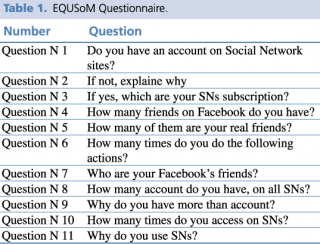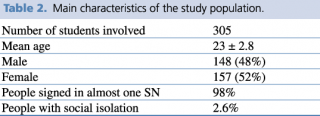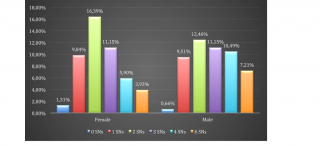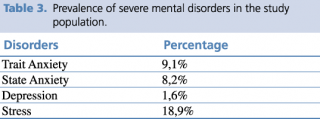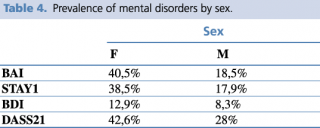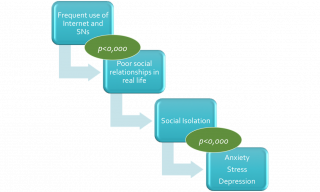Psychiatric disorders, social isolation and use of Social Networks in a sample of university students: a pilot study.
Laura Morciano,1 Giulia Lisi,2,3* Michele Ribolsi,2,3 Gianpiero Gallo,2 Carla Parisi,2 Alberto De Stefano,2,3 Francesca Lucaroni,1 Alessia Pesaresi,1 Sandro Mancinelli,1 Cinzia Niolu,2,3 Alberto Siracusano2,3 and Leonardo Palombi1
1Department of Biomedicine and Prevention, University of Rome “Tor Vergata”, Rome, Italy
2Department of Systems Medicine, University of Rome “Tor Vergata” Rome, Italy
3Psychiatry and Clinical Psychology Unit, Department of Neurosciences, Fondazione Policlinico "Tor Vergata" Rome, Italy
Introduction
There is some evidence of a strong association between social isolation and depressive and anxious symptoms in college students. On the contrary, there are controversial data on the link between the use of social networks (SNs) and mental health. Aim of this study is to evaluate the relation between social isolation, use of SNs and psychopathological measures in a sample of university students.
Design and Methods
Standardized instruments were administered to assess mental health and social isolation: Beck Depression Inventory; State-Trait Anxiety Inventory, version Y; Beck Anxiety Inventory; Depression, Anxiety and Stress Scale and the Lubben Scale for social isolation assessment. Number of daily accesses, number of Facebook contacts, number of friends among Facebook contacts and the total number of SNs have been reported.
Results
305 college students have been interviewed anonymously. Frequent use of SNs was strongly associated with social isolation, but no association was found with mental disorders. On the other hand, social isolation was associated with mental disorders.
Discussion
From an overall analysis of our results, we found a significant and independent association between the use of SNs and social isolation and between social isolation and mental disorders. However, further research is needed to explore this correlation in a wider sample.
Introduction
During young adulthood, college students are confronted with several challenges, including academic, social and personal needs.1 In addition to stress related to academic load, these students may have to face the task of taking on more adult-like responsibilities without having yet mastered skills and cognitive maturity of adulthood.2 Moreover, some of them may face potentially stressful experiences for the first time such as working, being in a significant relationship, or adapting to a new city or to a different social context. It is not unusual that some students may be employed full-time, so they have to cope with meeting work and family demands in addition to academic requirements.3 These high levels of stress, due to multiple responsibilities, make college students at greater risk of mental health problems. Accordingly, mental disorders are very common among college students:2 a survey included 71.860 US and Canadian college students, highlighted that for 33.9% of the students involved stress was the highest obstacle to a successful academic performance. Diagnosis of either depressive or anxiety disorders (major depression, anxiety disorder, or seasonal affective disorder) was the 6th obstacle affecting 16.1% of the students.4 Several studies suggest that college students show a higher prevalence of mental health problems than their non-student peers.5,6 Similarly, in a study conducted in two Australian universities most students (83.9%) reported higher levels of psychological distress compared to general population (29%).7 Frequently, loneliness may be a barrier to a student’s social development and represents a risk factor for their physical and mental health.8 Similarly, social isolation may have consequences for physical and mental health: individuals who are socially isolated may present increased morbidity and mortality,9 poor sleep quality,10 and increased risk of cognitive decline.11 For example, studies using the revised UCLA Loneliness Scale12 have found a strong association between loneliness and depressive symptoms in college student populations.13 A similar pattern has been found linking loneliness to greater anxious symptoms,13 indicating that loneliness may be a predictor of both depressive and anxious symptoms. Recently, it has been argued that the use of SN sites (SNs) may help to decrease social loneliness and to improve mental health.14,15 However, the results are still diverging and other studies showed that social loneliness and social avoidance were positively and statistically significantly related to time spent using Facebook in college students.16 Similarly, high internet adolescent users report more social isolation than low users.17
In this study, we aimed to evaluate social isolation and mental health status in a sample of university students. Moreover, we tried to investigate the presence of a correlation between psychopathological measures and the use of SNs.
Design and Methods
Study design was a single arm cross sectional survey. A sample of college students has been interviewed anonymously.
A new evaluation instrument – EQUSoM – (Evaluation Questionnaire for Use of Social Media) was set up by researchers of the 2 Departments of Biomedicine and Prevention and Systems Medicine in the period March-May 2015, in order to investigate the use of SNs among college students, in terms of behaviours and duration of the connection. The survey was carried out during the period June-September 2015, also to start a validation process of the instrument. In addition, standardized instruments were administered to respondents to assess mental health, well-being and social isolation. The standardized tools were: BDI Beck Depression Inventory,18 STAY1 State-Trait Anxiety Inventory, version Y,19 BAI Beck Anxiety Inventory,20 DASS21 Depression, Anxiety and Stress Scale21 and the Lubben Scale,22 for social isolation assessment.
EQUSoM investigated areas and items reported in Table 1.
In order to assess Social Networks use, number of daily accesses, number of Facebook contacts, number of friends among Facebook contacts and the total number of SNs they have been subscribed to be evaluated.
Data collected were assembled in a database and analysed with SPSS software, IBM Illinois v.23.
The descriptive statistical analysis involved the use of frequencies and percentages for quantitative variables, means and standard deviations for the qualitative ones. Spearman correlation was assessed in order to identify variables connection. Risk analysis was performed using univariate binary logistic regression.
Results
An overall number of 305 college students, 48% male and 52% female, answered anonymously to the tests. The mean age of participants was 23 ± 2,8 years. The main characteristics of the study population are described in Table 2. The 98% of students was logged in almost one SN, and all of them subscribed Facebook accessing more than once daily (74%). Women generally subscribed to one or two SNs, while men used more than four (OR=1.67; IC 1.06-2.6). Among students with no subscription to any SN, 66.7% were women, as shown in Figure 1.
Main characteristics of the study population
Differences among male and female in Social Networks behaviours
In the 62.5% of cases, the number of Facebook friends was higher than 100 with no differences between male and female. On the other hand, women had an overall number of real friends lower than male: in the 72% of the cases, the number of real friends among women was lower than 50, while among men this percentage was lower than 60% (OR 1.7; CI 1.1-2.8).
Social isolation resulting from the Lubben scale represented 2.6% of the respondents, while 17% of them were at risk. Students with social isolation had a mean age of 25.7 ± 3 years.
Prevalence of severe mental disorders is shown in Table 3.
Prevalence of the severe mental disorders in the study population
The same disorders were represented in a mild form with the following percentages:
-
State Anxiety: 21%
-
Trait Anxiety: 18.7%
-
Stress: 16%
-
Depression: 8.8%
Mental disorders were significantly more represented in women, as shown in Table 4.
Prevalence of mental disorders by sex
The risk of anxiety and stress disorders was higher in women than in men (OR 2.2; CI 1.5-3.2 and OR 1.5; CI 1.1-2, respectively).
High use of SNs was statistically significant associated with poor relationships in real life (p<0,001), but no association was found with mental disorders. On the other hand, social isolation was associated with mental disorders with a p value<0,001, as shown in Figure 2.
Relationship beween Internet use, social isolation and mental disorders
Discussion
To date, this study is the first to examine the associations between a panel of mental disorders, social isolation and the use of online SNs among young adults, and to do so in a large randomly selected sample of university students in Italy. We found several significant results.
Firstly, for what concerns the use of Internet and SNs, we found that 98% of our sample has at least one account on a SN, and the 74% of those referred to log in more than once a day. In particular, male students have access to a greater number of SNs.
Second, 17% of our sample resulted unexpectedly to be at risk for social isolation and 2,6% of the sample resulted to be socially isolated.
Literature lacks of consistent data concerning the distribution of social isolation among community-samples of young adults. Chou KL and colleagues studied a nationally representative sample of 34,653 American community-dwelling adults finding that many Americans lacking of frequently contacted close friends in their social network.23 A number of studies have shown that relationships with other people, being a member of a supportive social and parental network can have a concrete influence on subjective wellbeing.24,25 Social support is considered in fact as a psychosocial coping resource that positively affects personal resources such as self-esteem and self-efficacy and buffers the negative effects of stress.26 Through these mechanisms, social support can influence emotional health and wellbeing.27 An extensive literature, examining a variety of populations, documents strong associations between social support and mental health.26-32 For example, psychologically distressed persons are consistently found to be more socially isolated;27 less contacts with friends, lack of a partner or someone to confide in, and feeling alone are also related to higher levels of psychological distress.30,33 Social support was found to have a stronger relationship with psychological distress than conditions of poverty.29
In our sample, intriguingly social isolation resulted strongly related to a more consistent use of SNs: in facts, the subjects with a greater use of online SNs resulted to be at major risk for social isolation.
The effect of SNs use on psychological wellbeing is controversial: on one hand, frequent message exchange between SNs friends may help people to form stronger relationships;34,35 conversely, others contend that these newly available SNs relationships are superficial or ephemeral, and that they displace authentic face to face contact, which in turn leads to social isolation and dismantles social cohesion.36,37
In an attempt to justify this strong relationship in our sample between social isolation and use of SNs, we could imagine the occurrence of two different mechanisms cause and effect: the first that isolated individuals or risk isolation would build virtual relationships in an attempt to make up for the deficient friendships in real life, the second, according to which the use of the same Internet would have a progressive role in inducing a consistent withdrawal of the subject in an isolated dimension from the real world.
No direct relation between psychiatric disorders (anxiety or depression) and use of SNs was found in our sample, but our results interestingly highlighted the existence of a strong relation between social isolation and both depressive and anxiety disorders.
The existence of a relation between social isolation and mental disorders including major depressive disorder, dysthymic disorder, social anxiety disorder and generalized anxiety disorder has been widely described in literature.38-42 This is in line with recent studies in the animal model which provided strong evidence that social isolation leads to the expression of a variety of behaviours linked with increased vulnerability to anxiety, including deficits in sensory gating and fear extinction, and increases in anxiety measures and ethanol drinking.20
From an overall analysis of our results, we found a 2-stage significant and independent association between the use of SNs and social isolation and between social isolation and mental disorders correlation that links the use of SNs to social isolation and social isolation to anxiety (see fig. 2). However, further research is needed to explore this correlation in a larger sample and in a wider panel of mental disorders. Moreover, in this study all the questionnaires used were self-administered and a bias dictated from an auto selection of respondents needs to be considered. Another limit of the study is that EQUSoM to date is not validated. However, we did not find a proper similar instrument in the investigated area.
References
- Al-Daghri NM, Al-Othman A, Albanyan A, Al-Attas OS, Alokail MS, Sabico S, et al. Perceived Stress Scores among Saudi Students Entering Universities: A Prospective Study During the First Year of University Life. Int J Environ Res Public Health. 2014; 11(4): 3972-81.
- Pedrelli P, Nyer M, Yeung A, Zulauf C, Wilens T. College Students: Mental Health Problems and Treatment Considerations. Acad Psychiatry. 2015; 39(5): 503-11.
- Staats S, Cosmar D, Kaffenberger J. Sources of Happiness and Stress for College Students: A Replication and Comparison Over 20 Years. Psychol Rep. 2007; 101(3 Pt 1): 685-96.
- Association. ACH. National College Health Assessmentspring 2007 Reference Group Data Report (Abridged). J Am Coll Health. 2008; 56: 469-79.
- Cvetkovski S, Reavley NJ, Jorm AF. The Prevalence and Correlates of Psychological Distress in Australian Tertiary Students Compared to Their Community Peers. Aust N Z J Psychiatry. 2012; 46(5): 457-67.
- Slutske WS, Hunt-Carter EE, Nabors-Oberg RE, Sher KJ, Bucholz KK, Madden PA, et al. Do College Students Drink More Than Their Non-College-Attending Peers? Evidence From a Population-Based Longitudinal Female Twin Study. J Abnorm Psychol. 2004;113(4):530-40.
- Stallman HM, McDermott BM, Beckmann MM, Kay Wilson M, Adam K. Women Who Miscarry: the Effectiveness and Clinical Utility of The Kessler 10 Questionnaire in Screening for Ongoing Psychological Distress. Aust N Z J Obstet Gynaecol. 2010; 50(1): 70-6.
- Krause-Parello CA. Loneliness in the School Setting. J Sch Nurs. 2008; 24(2): 66-70.
- Holt-Lunstad J, Smith TB, Layton JB. Social Relationships and Mortality Risk: A Meta-Analytic Review. PLoS Med. 2010; 7(7): e1000316.
- Friedman EM. Sleep Quality, Social Well-Being, Gender, and Inflammation: An Integrative Analysis in a National Sample. Ann N Y Acad Sci. 2011; 1231: 23-34.
- Barnes LL, Mendes de Leon CF, Wilson RS, Bienias JL, Evans DA. Social Resources and Cognitive Decline in a Population of Older African Americans and Whites. Neurology. 2004; 63(12): 2322-6.
- Russell D, Peplau LA, Cutrona CE. The revised UCLA Loneliness Scale: Concurrent and Discriminant Validity Evidence. J Pers Soc Psychol. 1980; 39(3): 472-80.
- Jackson J, Cochran SD. Loneliness and Psychological Distress. J Psychol. 1991; 125(3): 257-62.
- Aarts S, Peek ST, Wouters EJ. The Relation between Social Network Site Usage and Loneliness and Mental Health in Community-Dwelling Older Adults. Int J Geriatr Psychiatry. 2015; 30(9): 942-9.
- Bonetti L, Campbell MA, Gilmore L. The Relationship of Loneliness and Social Anxiety with Children's and Adolescents' Online Communication. Cyberpsychol Behav Soc Netw. 2010; 13(3): 279-85.
- Lemieux R, Lajoie S, Trainor NE. Affinity-Seeking, Social Loneliness, and Social Avoidance Among Facebook Users. Psychol Rep. 2013; 112(2): 545-52.
- Sanders CE, Field TM, Diego M, Kaplan M. The Relationship of Internet Use to Depression and Social Isolation among Adolescents. Adolescence. 2000; 35(138): 237-42.
- Beck AT SR, Brown GK. BDI-II Manual. San Antonio: The Psychological Corporation; 1996.
- Spielberger. Preliminary Manual for the State-Trait Personality Inventory. Tampa, Fl: University of South Florida; 1996.
- Butler TR, Karkhanis AN, Jones SR, Weiner JL. Adolescent Social Isolation as a Model of Heightened Vulnerability to Comorbid Alcoholism and Anxiety Disorders. Alcohol Clin Exp Res. 2016; 40(6): 1202-14.
- Lovibond SH LP. Manual for the Depression Anxiety Stress Scales. Sydney: Psychology Foundation; 1995.
- Lubben J. Assessing Social Networks Among Elderly Populations. Family & Community Health. 1988; 11(3): 42-52.
- Chou KL, Liang K, Sareen J. The Association between Social Isolation and DSM-IV Mood, Anxiety, and Substance Use Disorders: Wave 2 of the National Epidemiologic Survey on Alcohol and Related Conditions. J Clin Psychiatry. 2011; 72(11): 1468-76.
- Huxhold O, Fiori KL, Windsor TD. The Dynamic Interplay of Social Network Characteristics, Subjective Well-Being, and Health: The Costs and Benefits of Socio-Emotional Selectivity. Psychol Aging. 2013; 28(1): 3-16.
- Khan A, Husain A. Social Support as a Moderator of Positive Psychological Strengths and Subjective Well-Being. Psychol Rep. 2010; 106(2): 534-8.
- Thoits PA. Stress, Coping, and Social Support Processes: Where Are We? What Next? J Health Soc Behav. 1995; Spec No: 53-79.
- Kawachi I, Berkman LF. Social Ties and Mental Health. J Urban Health. 2001; 78(3): 458-67.
- Berkman LF, Glass T, Brissette I, Seeman TE. From Social Integration to Health: Durkheim in the New Millennium. Soc Sci Med. 2000; 51(6): 843-57.
- Caron J, Latimer E, Tousignant M. Predictors of Psychological Distress in Low-Income Populations of Montreal. Can J Public Health. 2007; 98 Suppl 1: S35-44.
- Coyne JC, Downey G. Social Factors and Psychopathology: Stress, Social Support, and Coping Processes. Annu Rev Psychol. 1991; 42:401-25.
- House JS, Landis KR, Umberson D. Social Relationships and Health. Science. 1988; 241(4865): 540-5.
- Leung KK, Chen CY, Lue BH, Hsu ST. Social Support and Family Functioning on Psychological Symptoms in Elderly Chinese. Arch Gerontol Geriatr. 2007; 44(2): 203-13.
- Stravynski A, Boyer R. Loneliness in Relation to Suicide Ideation and Parasuicide: A Population-Wide Study. Suicide Life Threat Behav. 2001; 31(1): 32-40.
- Baek YM, Bae Y, Jang H. Social and Parasocial Relationships on Social Network Sites and Their Differential Relationships with Users' Psychological Well-Being. Cyberpsychol Behav Soc Netw. 2013; 16(7): 512-7.
- Manago AM, Taylor T, Greenfield PM. Me and My 400 Friends: the Anatomy of College Students' Facebook Networks, Their Communication Patterns, and Well-Being. Dev Psychol. 2012; 48(2): 369-80.
- Gentzler AL, Oberhauser AM, Westerman D, Nadorff DK. College Students' Use of Electronic Communication with Parents: Links to Loneliness, Attachment, and Relationship Quality. Cyberpsychol Behav Soc Netw. 2011; 14(1-2): 71-4.
- Park J, Lee DS, Shablack H, Verduyn P, Deldin P, Ybarra O, et al. When Perceptions Defy Reality: the Relationships between Depression and Actual and Perceived Facebook Social Support. J Affect Disord. 2016; 200: 37-44.
- Teo AR, Lerrigo R, Rogers MA. The Role of Social Isolation in Social Anxiety Disorder: A Systematic Review and Meta-Analysis. J Anxiety Disord. 2013; 27(4): 353-64.
- Linge R, Pazos A, Diaz A. Social Isolation Differentially Affects Anxiety and Depressive-Like Responses of Bulbectomized Mice. Behav Brain Res. 2013; 245: 1-6.
- Wittchen HU. The Many Faces of Social Anxiety Disorder. Int Clin Psychopharmacol. 2000; 15 Suppl 1: S7-12.
- Liu JH, You QL, Wei MD, Wang Q, Luo ZY, Lin S, et al. Social Isolation During Adolescence Strengthens Retention of Fear Memories and Facilitates Induction of Late-Phase Long-Term Potentiation. Mol Neurobiol. 2015; 52(3): 1421-9.
- Teo AR. Social Isolation Associated with Depression: A Case Report of Hikikomori. Int J Soc Psychiatry. 2013; 59(4): 339-41.



